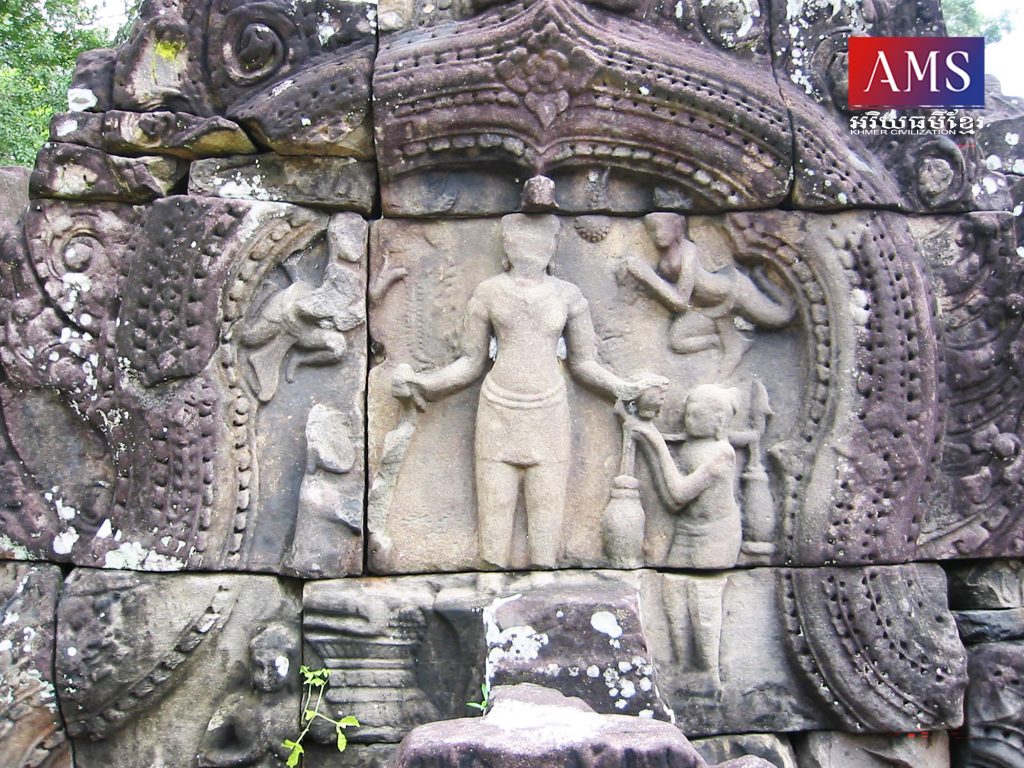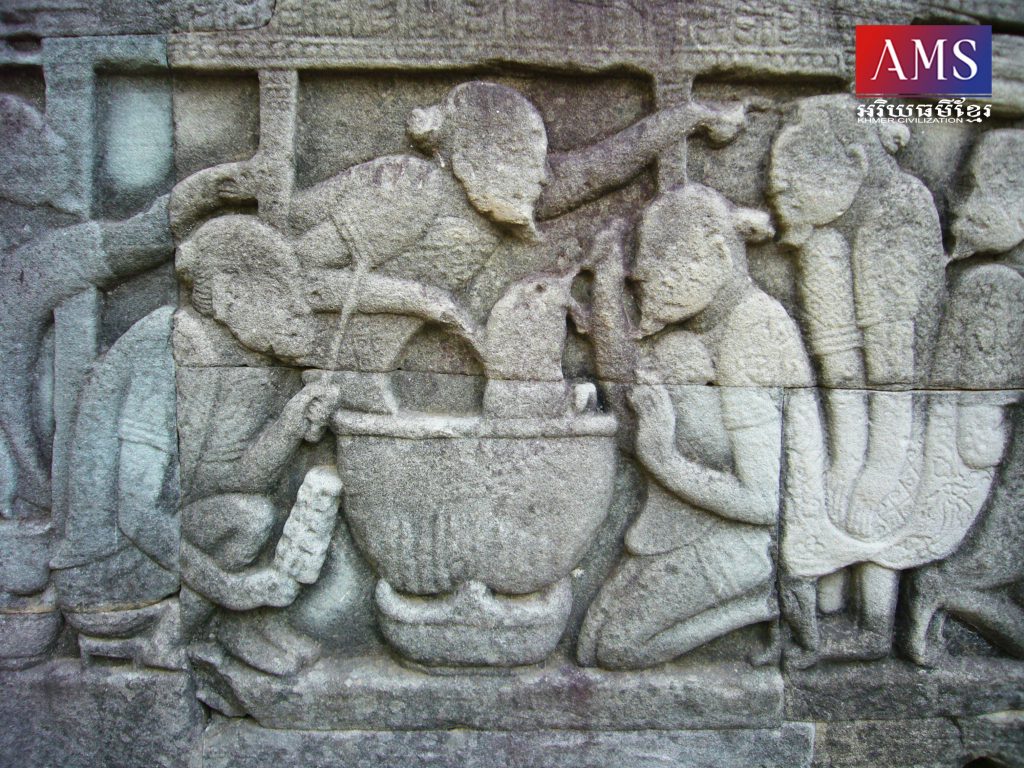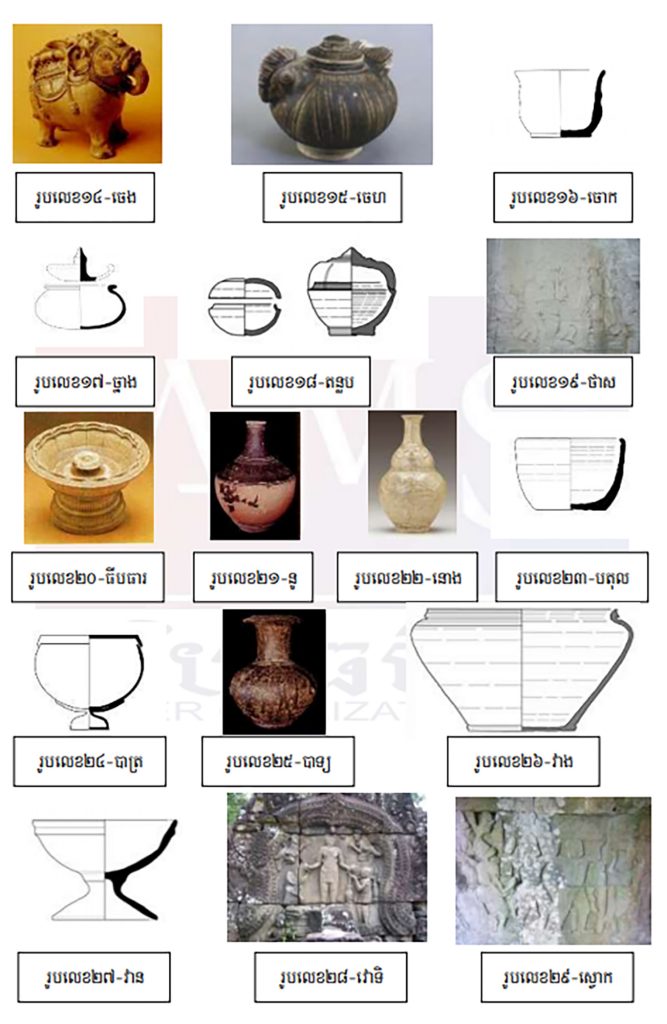នានាភាពនៃកុលាលភាជន៍ គឺមានន័យសំដៅទៅលើប្រភេទឬរូបរាងផ្សេងៗរបស់ភាជន៍ ពិសេសគឺផ្តោតជាសំខាន់ទៅលើពាក្យដែលខ្មែរនាសម័យបុរាណបានប្រើប្រាស់សម្រាប់ហៅភាជន៍ដែលមានរូបរាងខុសគ្នា។ នៅក្នុងអត្ថបទ ភាគ២ ស្តីអំពីលក្ខណៈទូទៅនៃកុលាលភាជន៍ខ្មែរសម័យអង្គរ ខ្ញុំបានបង្ហាញត្រួសៗរួចហើយក្នុងគេហទំព័រ AMS អរិយធម៌ខ្មែរ អំពីប្រភេទ ឬរូបរាងភាជន៍ដែលយើងបានជួបប្រទះនៅតាមបណ្តាឡបុរាណមួយចំនួនក្នុងតំបន់អង្គរ និងតាមបណ្តាស្ថានីយប្រវត្តិសាស្ត្រផងដែរ។ ការសិក្សាលើរូបរាងផ្សេងៗ និងពាក្យដែលប្រើប្រាស់ទាំងនេះ គឺពឹងផ្អែកទាំងស្រុងលើសិលាចារឹកខ្មែរសម័យបុរាណ ទាំងអត្ថបទភាសាជាសំស្ក្រឹត ទាំងអត្ថបទជាភាសាខ្មែរ ដោយប្រៀបធៀបជាមួយនិងពាក្យខ្មែរបច្ចុប្បន្ន និងភាសាអំបូរមនខ្មែរមួយចំនួនផង។ ក្នុងអត្ថបទនេះ ខ្ញុំនិងលើកមកសង្ខេបជាថ្មី ជាខេមរភាសា។ ជាធម្មតា យើងសព្វថ្ងៃប្រើពាក្យសម្គាល់លើភាជន៍ដែលមានរូបរាងខុសគ្នា តែជាងដប់ពាក្យប៉ុណ្ណោះ។ ប៉ុន្តែបើពិនិត្យតាមសិលាចារឹក ឃើញថា៖ ខ្មែរបុរាណមានប្រើពាក្យប្រហែល៣៧ ទាំងភាសាសំស្ក្រឹតនិងភាសាខ្មែរ សម្រាប់ហៅភាជន៍ដែលមានរូបរាងខុសៗគ្នា។
តើពាក្យទាំងនោះមានអ្វីខ្លះ?
ដើម្បីអោយងាយយល់ ខ្ញុំនិងរៀបតាមលំដាប់ ស្រះ និងព្យញ្ជនៈខ្មែរ ជាលំអានដូចជា៖ (១) អ៌ឃ្យ /Arghya/ (២) អាង /Āṅ/ (៣) កថាហ/កទាហ/គទាហ /Kaṭāha, kadāha, gadāha/ (៤) កថោរ /Kathor/ (៥) កន្ទិន/ទិន /kandin, din/ (៦)កន្លោ /Kanlo/ (៧) កមណឌលុ /Kamaṇḍalu/ (៨)ករងក /Karaṅka/ (៩)កលស /Kalaśa / (១០) កុន្ទិ/កន្តិ/កុន្តិកា/កុន្ទក /Kunti, kanti, kuntikā, kundaka/ (១១) កុសុម្ភ /Kusumbha/ (១២) កោស/កោឝ /Kośa, koça/ (១៣) ក្លស/ខ្លស/ក្លាស / Klas, khlas, khlās/ (១៤) ខាល/ខល /Khāl, khal/ (១៥) ខ្លែង /Khleṅ/ (១៦) ចាន /Cān/ (១៧) ចេង /Ceṅ/ (១៨) ចេហ /Ceh/ (១៩) ចោក /Cok/ (២០) ច្នង/ឆ្នាង /Cnaṅ, Chnāṅ/ (២១) តន្លប/តន្លាប /Tanlap, Tanlāp/ (២២) ថាស /Thās/ (២៣) ទីបធារ /Dīpathāra/ (២៤) ទ្លហ /Dlas/ (២៥) នូ/នុ /Nū, nu/ (២៦) នោង /Noṅ/ (២៧) បតុល /Patula/ (២៨) បទិគ្រហ/បទិគហ /Padigraha, Padigah/ (២៩) បាត្រ /Pātra/ (៣០) បាទ្យ /Pādya/ (៣១) វរធណី /Vardhaṇī/ (៣២) វាង/វាញ /Vāṅ, Vāñ/ (៣៣) វាន /Vān/ (៣៤) វៅទិ/វោទិ /Vaudi, Vodi/ (៣៥)ស្ថាលិ /Sthāli/ (៣៦) ស្វោក/ស្វៅក /Svok, Svauk/ និង(៣៧)សរាវ/សរាវណ /Sarāva, Sarāvaṇa/។
តាមរយៈការសិក្សាជាលើកដំបូងនេះ យើងអាចនិយាយបានថា សិលាចារឹកខ្មែរសម័យបុរាណមានសារសំខាន់ និងផលប្រយោជន៍ក្នុងការយល់ដឹងអំពីកុលាលភាជន៍ និងភាជន៍ធ្វើពីលោហៈផ្សេងៗរបស់ខ្មែរ។ តាមរយៈវាក្យស័ព្ឌនីមួយៗ យើងក៏អាចធ្វើចំណាត់ថ្នាក់លើនានាភាពនៃភាជន៍ទាំងប្រភេទឬរូបរាង ទោះជារូបរាងពិតប្រាកដរបស់ភាជន៍មួយចំនួននៅមិនទាន់អាចស្គាល់ច្បាស់ក៏ដោយ។ ជាបណ្តោះអាសន្ន ពាក្យជិត៤០ ទាំងភាសាខ្មែរនិងសំស្ក្រឹត យើងអាចស្គាល់ថា ជាពាក្យដែលត្រូវបានខ្មែរនាសម័យបុរាណប្រើប្រាស់សម្រាប់សម្គាល់និងហៅចំពោះភាជន៍ដែលមានរូបរាងផ្សេងៗគ្នា។ ក្នុងនោះពាក្យមួយចំនួន ដោយការសិក្សាប្រៀបធៀបនិងពាក្យសម័យថ្មី យើងអាចស្គាល់ពីរូបរាងរបស់ភាជន៍បាន។ ក្រៅពីនេះ យើងអាចដឹងពីភាជន៍មួយចំនួនដែលអាចនាំចូលពីបរទេស ដូចជា ឥណ្ឌា និងចិនជាដើម។
——————————————-
Variety of Khmer ceramic on Angkor period (Part 3)
Variety of ceramic refers to different types or shapes of ceramic, especially focusing on the words that the ancient Khmer used to call ceramic of different shapes. In the second article on the general characteristics of Angkorian Khmer ceramic, I have already stated the types or shapes of ceramic that we have encountered in some of the ancient kilns in the Angkor area and at historical sites as well. The study of these various shapes and these terms are entirely dependent on ancient Khmer inscriptions, both Sanskrit and Khmer by comparing with modern Khmer words and some Khmer Mon languages. Today we generally use the marking word on ceramic that there are different shapes, but they have over ten words. However, according to the inscriptions, the ancient Khmer used about 37 words in both Sanskrit and Khmer.
What are those words?
In order to make it more convenient to understand, I will arrange the order of the Khmer vowels and alphabet such as:
(1) Arghya (2) Āṅ (3) Kaṭāha, kadāha, gadāha (4) Kathor (5) kandin, din (6) /Kanlo/ (7) Kamaṇḍalu (8) Karaṅka (9) Kalaśa (10) Kunti, kanti, kuntikā, kundaka (11) Kusumbha (12) Kośa, koça (13) Klas, khlas, khlās (14) Khāl, khal (15) Khleṅ (16) Cān (17) Ceṅ (18) Ceh (19) Cok (20) Cnaṅ, Chnāṅ (21) Tanlap, Tanlāp (22) Thās (23) Dīpathāra (24) Dlas (25) Nū, nu (26) Noṅ (27) Patula (28) Padigraha, Padigah (29) Pātra (30) Pādya (31) Vardhaṇī (32) Vāṅ, Vāñ (33) Vān (34) Vaudi, Vodi/ (35) Sthāli (36) Svok, Svauk/ និង(37)Sarāva, Sarāvaṇa។
Based on this initial study, we can say that the ancient Khmer inscriptions are important and useful in understanding the ancient Khmer ceramic and ceramic made of various metals. Through each vocabulary, we can also classify the variety of ceramics by type or shape, although the exact shape of some ceramics is still unknown. In the meantime, nearly 40 words in both Khmer and Sanskrit can be identified as words used by ancient Khmers to identify and call to ceramic of various shapes. In some words by comparative study and modern words, we can recognize the shape of the ceramic. Besides, we also realize some ceramics that can be imported from abroad namely India and China.
អត្ថបទដើម៖ លោក សុខ កែវ សុវណ្ណារ៉ា










